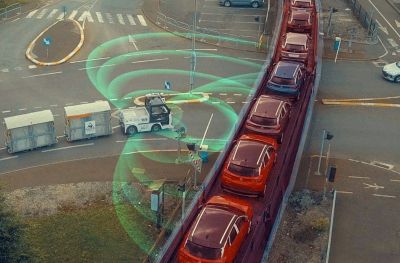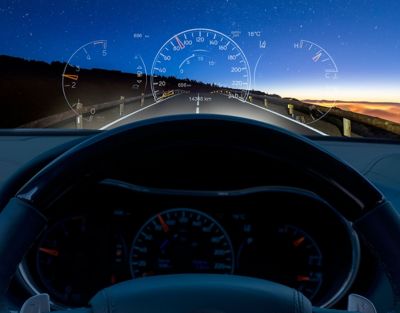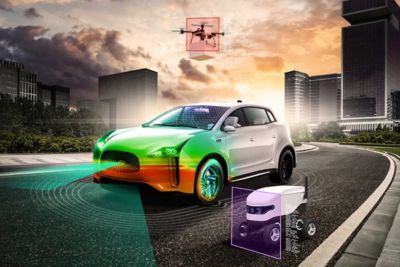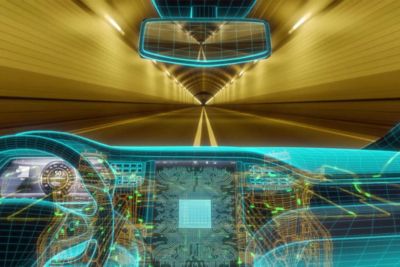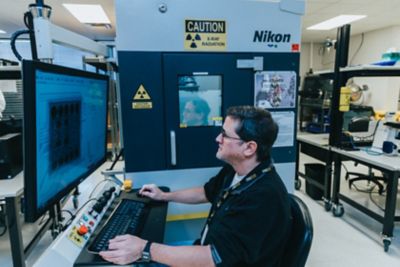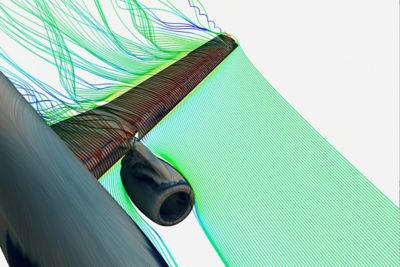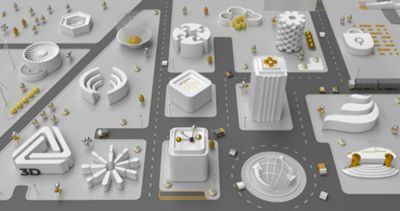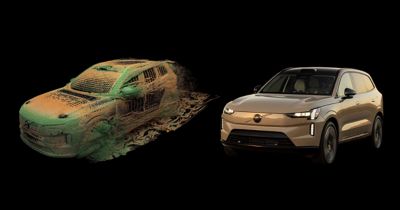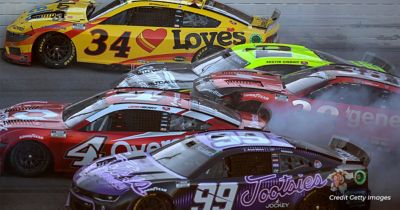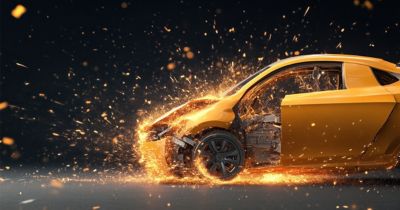Check out this installment of the “Ask the Engineer” blog series for insights from a NASCAR engineer on simulation and safety in a crash-prone motorsport.
What if every time you sat behind the wheel required you to mentally prepare for an accident? Would you hit the road or hang up your keys? For NASCAR drivers, racing is all about high speeds and high stakes. And at the end of the day, they have to be able to walk away from a crash, return to the track the next day, and do it all over again.
In fact, over the past decade, according to NASCAR, the NASCAR Cup Series has averaged about 170 crash incidents per season, or about 4.5 per race. It’s not surprising, really. When you have between 36 and 40 cars driving at about 200 mph on the track, a slight bump can send a car spinning into a steel and foam energy reduction (SAFER) barrier or cause a 10-car pileup. The good news: Despite the number of hard wrecks, most drivers walk away safely.
Is it magic or engineering? For NASCAR, it’s all about engineering. In this new installment of our “Ask the Engineer” blog series, you’ll hear John Patalak, vice president of safety at NASCAR, explain how his team uses Ansys LS-DYNA nonlinear dynamics structural simulation software to optimize the Next Gen chassis design for extreme safety.
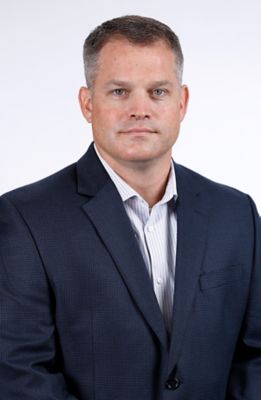
John Patalak, vice president of safety at NASCAR
From your perspective, what is crashworthiness in NASCAR? What elements of the Next Gen car are coming together to support it?
John Patalak: I like to think of crashworthiness like we’re working from a clean sheet of paper in terms of design. Real life is messy with existing inventory and parts and obsolescence and things like that. But if we’re just going to start fresh, which is pretty close to how Next Gen was done, we really want to have a vehicle that’s going to balance vehicle chassis crash accelerations with intrusion prevention.
From a vehicle standpoint, we want a car to do three things. We want to design a driver survival space against intrusion. We want to manage the chassis so that the peak accelerations are as low as possible. And we want to make sure that the chassis has fuel system integrity against crash to reduce the risk of fires or electrolyte leaks, whatever our propulsion or energy source is — whether it’s battery, hydrocarbon liquid fuel, or hydrogen gas.
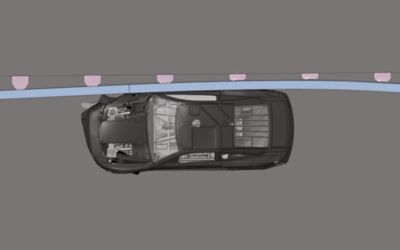
Top-down view of a NASCAR crash simulation: a detailed Ansys LS-DYNA nonlinear dynamics structural simulation software view of the NASCAR Next Gen car during a severe right frontal impact with the steel and foam energy reduction (SAFER) barrier
With a single part supplier and a chassis designed by NASCAR, how does safety translate among the Chevrolet, Ford, and Toyota cars?
Patalak: There is one chassis from the front bumper to the rear bumper for all. It’s the same for the structural elements of the vehicle. Now when you get to the body, if you step back from these cars, the body is not a primary structure for crashing. It does add some stiffness, but it’s a very small amount compared to the overall amount of stiffness that the chassis brings.
Crashworthiness is baked into the steel chassis design, and the body that goes on top is unique for Chevy, Ford, and Toyota. On the outside, all three brands do share some common elements like the roof. But the body sides, the rear fascia, all the way around to the back and then the hood and the nose, those are all unique.
Do you have an estimate of how much testing was done over the entire Next Gen design cycle?
Patalak: NASCAR did over 5,000 crash simulations over multiple years. Each one takes hours to run and post-process. To optimize rear impact structure, we would simplify the car into subsections. You have simulations running overnight every night. During the day, all the engineers are analyzing and post-processing all those results.
Initially, we’d have a meeting every two weeks with everyone, and then for about six months we’d have about two to three meetings a week. So basically, we’d review the results coming out of the LS-DYNA simulations together. It would be Dallara, Elemance, external consulting experts, and NASCAR.
It was a global effort. We’d have people in Italy, North Carolina, Indiana, and other states all meeting online. The engineers are scribbling on the screen and looking at CAD and graphs. We’d then decide when to submit the next batch of simulations — let’s say by 4 p.m. Eastern Standard Time (EST) if we want to have results to talk about by tomorrow morning at 11 EST.
Did You Know?
Like Ansys, Lego is in the modeling business. What, exactly, does this have to do with NASCAR?
In March 2023, the toymaker, with input from NASCAR, gave fans something to really be excited about — the Lego Technic NASCAR Next Gen Chevrolet Camaro ZL1. The model includes realistic replicas of some of the Next Gen’s key features, right down to an open hood revealing a V8 engine with moving pistons.
“Within NASCAR, when the Next Gen car came out it was great because Lego made a Next Gen Camaro,” says John Patalak, vice president of safety at NASCAR. “We had a Lego box, and as engineers, well, most mechanical engineers used to love Legos. When they made our car into a Lego set, it felt like we had kind of arrived.”

Dr. Sayak Mukherjee analyzes an LS-DYNA crash simulation while immersed in a NASCAR workspace, including the LEGO® Technic™ NASCAR® Next Gen Chevrolet Camaro ZL1.
What type of analysis did you focus on using LS-DYNA software?
Patalak: Basically, for rear impacts all of that simulation we did with the goal of minimizing peak accelerations and cross-sectional forces through the fuel cell for fuel integrity during rear impact. We used a lot of simulation tools to get close on the design. Then, within the simulation, we would apply different boundary conditions.
Once we arrived at the best design for the given space for rear impacts, for example, we would start looking at side impacts, frontal impacts, frontal oblique impacts, T-bone crashes, and roof impacts. It’s an iterative process that really almost never stops until you run out of time in your design schedule. You’re always trying to tweak the design to squeeze out a little bit more performance in one area without making it worse in another.
And then? From a crash safety standpoint, we would find a nugget we really liked. Dallara would have to go back and check against their vehicle maneuvering loads to make sure that any tweaks wouldn’t cause plastic deformation in a frame element, or control arm, or some other aspect of the rear impact structure.
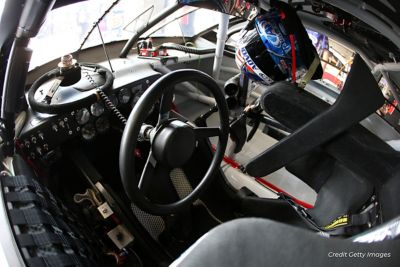
Inside the cockpit of a race car: A close-up look reveals a stripped-down and high-performance interior, engineered for maximum driver safety and vehicle control. Comfort takes a back seat to function, with minimal insulation from noise, vibration, and harshness.
In terms of overall responsiveness, what are you looking for from the chassis?
Patalak: If you watch NASCAR, the drivers like to beat and bang a lot. There’s a lot of contact. On road courses, they’re jumping curbs constantly for the whole race. That’s really hard on the suspension mounting points and the front and rear suspension assemblies where all four corners and all four wheels attach.
At Bristol Motor Speedway or Daytona International Speedway, for example, the maximum banking going into the corners is 30 to 31 degrees. The wheel loads are massive. The car suspension structures have to live through all of that in the material elastic range. From a maneuvering or driving standpoint, you don’t want a front clip that you could only race two or three times and then things start cracking or bending.
You don’t want the car chassis to bend during normal NASCAR driving. But you do want it to bend in a controlled, predictable fashion as soon as it hits the wall. Really the only way to accomplish this level of engineering and move on with confidence is simulation.
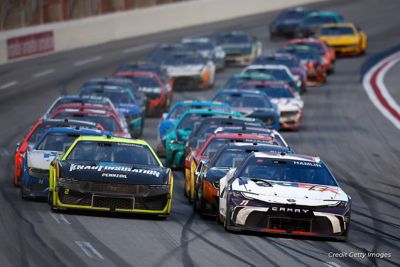
What’s the importance of crash data during your analysis?
Patalak: We’ll take all the information from our crash data system within our crash database, including the empirical crash accelerations, and we’ll use it to reconstruct the actual crash scenario in LS-DYNA software. We’ll take all the relevant boundary condition information — the speed, the angle, the rotations, everything that we have out of the car — and we’ll start replicating that within LS-DYNA software.
On most weeks my job is Monday to Friday. But often, when I’m at home, I’ll watch a race on TV, and I’ll think, “If that had happened a little differently, I don’t know how the car would have responded.” With the data, we’re always trying to make sure that our model is predicting pretty closely to what actually happened in a crash. It’s not so much validating the model anymore. We’re pretty confident in that. It’s more so that we have the boundary conditions just right.
We want to thank John Patalak for his time. If you liked this interview, you may want to check out Simulation Helps NASCAR Assess the Impact of SAFER Barriers.
Just for you. We have some additional resources you may enjoy.
“Really the only way to accomplish this level of engineering and move on with confidence is simulation.”
— John Patalak, vice president of safety, NASCAR
